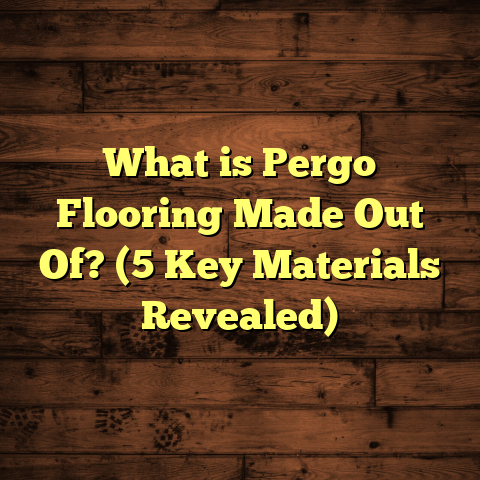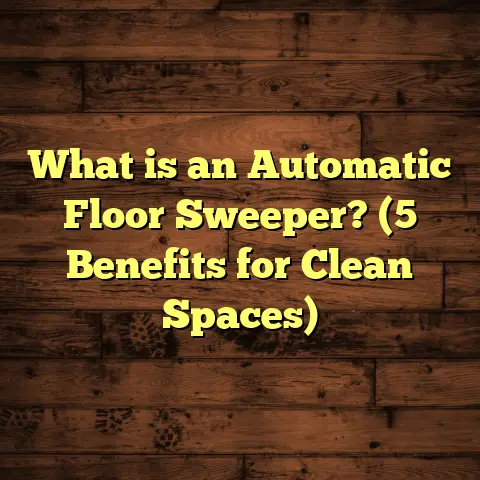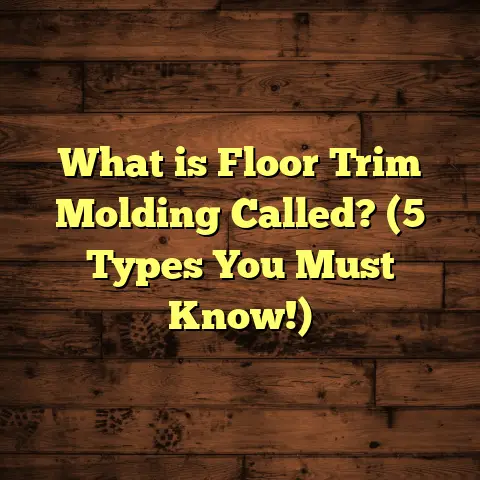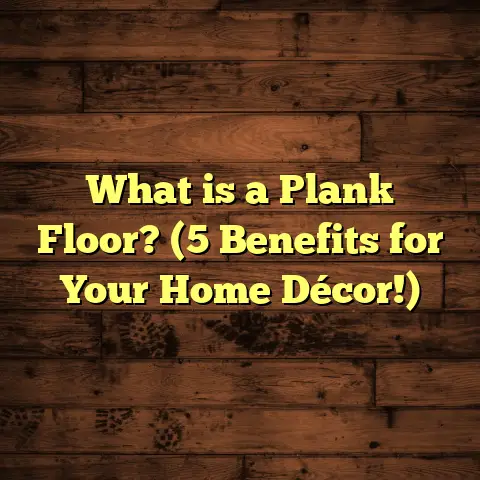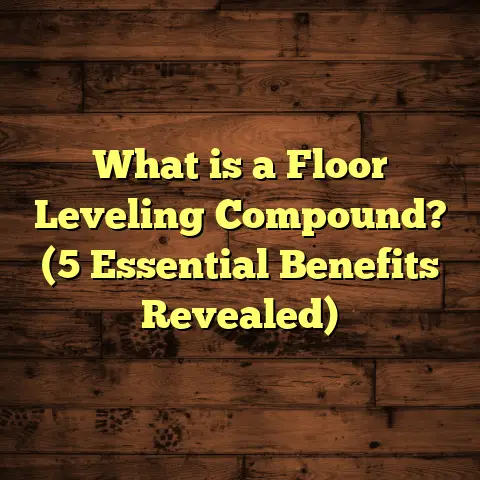What is Kitchen Flooring Called? (5 Must-Know Types & Styles)
I still remember the smell of my grandma’s kitchen floor—the smooth, cool surface beneath my feet as I helped her bake cookies. That floor wasn’t just a surface; it was a foundation of memories. Kitchen flooring sets the tone for one of the most important rooms in any home, balancing style, comfort, and practicality. But have you ever stopped to wonder what that flooring is really called and what options you actually have? Let me walk you through everything I’ve learned over the years about kitchen flooring and share some stories and facts that might help you make the right choice for your kitchen.
What Is Kitchen Flooring?
Kitchen flooring refers to the material or surface that covers the floor area in a kitchen. It has to handle everything from spills and heavy foot traffic to hot pots dropped on it by accident. The key here is durability mixed with style because this is where you cook, eat, and gather with family.
When I first started working with clients on kitchen renovations, they often asked me what type of flooring would last the longest or look the best. The answer? It depends on your lifestyle, budget, and the overall look you want.
To give you a clearer picture: kitchen floors usually cover anywhere from 100 to 400 square feet in a typical home. The cost to install varies widely—some budget-friendly options start around $3 per square foot, while premium materials can go over $15 per square foot installed. Installation time ranges between one to four days depending on the material and room size.
Let’s break down the five must-know types and styles of kitchen flooring that I’ve seen work wonders in different homes.
1. Ceramic and Porcelain Tile: The Classic Choice
Ceramic and porcelain tiles are probably the most traditional kitchen floors. They’ve been around for decades, and for good reason—they are tough, water-resistant, and come in endless designs.
Why Choose Tile?
When I worked on a kitchen remodel in Chicago, the homeowners chose porcelain tiles because their kids were always dropping things and making messes. The tiles held up beautifully, and cleanup was easy. Plus, porcelain is denser than ceramic, making it more durable in high-traffic areas.
Tiles typically measure 12×12 inches or sometimes larger like 18×18 inches. Costs range from $5 to $10 per square foot for materials alone, with installation adding another $4 to $8 per square foot. Expect the project to take about two to three days for an average-sized kitchen.
Durability and Maintenance
Tiles can be cold underfoot during winter — a friend of mine solved this by installing radiant heat beneath the tiles, which costs about $10 to $15 per square foot extra but makes a huge difference.
Grout lines require sealing every few years to prevent staining and mildew buildup. The cost for sealing grout is roughly $0.50 to $1 per square foot.
Design Flexibility
Tiles come in countless colors, patterns, and finishes—from matte to high gloss—and can mimic natural stone or even wood grain. This versatility means you can create anything from a rustic farmhouse vibe to sleek modern kitchens.
Real-Life Example
A client in Boston installed 16×16 porcelain tiles in a light gray tone paired with dark grout. This combination hid dirt well and gave a contemporary feel. After three years, the floor still looked brand new despite a busy household with pets.
2. Hardwood Floors: Warmth Meets Durability
Hardwood floors in kitchens bring warmth and timelessness. I remember installing a solid oak floor in a farmhouse kitchen last year; it transformed the whole space with its natural grain and rich color.
Types of Hardwood
Solid hardwood comes in planks usually 2 1/4 to 3 1/4 inches wide and thickness between 3/4 inch. Prices vary widely depending on species—oak, maple, or hickory are common choices priced between $6 and $12 per square foot installed.
Longevity and Care
One thing I always tell clients is hardwood needs regular maintenance—sealing every few years protects against moisture damage common in kitchens. On average, refinishing the floor every 7-10 years costs about $2 per square foot.
In terms of lifespan, hardwood can last over 50 years if cared for well. But if you’re worried about water spills or pet accidents, engineered hardwood might be a better pick.
Personal Story
I recall a couple in Denver who had solid walnut floors installed in their kitchen. They loved the rich color but quickly learned that splashes near the sink required immediate cleaning to avoid water stains. After adding felt pads under stools and a couple of area rugs near work areas, their floors stayed beautiful for years.
3. Engineered Hardwood: The Best of Both Worlds
Engineered hardwood looks like traditional hardwood but is constructed differently—it has a thin layer of real wood veneer on top of plywood layers underneath.
Benefits Over Solid Hardwood
I recommended this option to a client in Seattle who loved hardwood aesthetics but wanted better moisture resistance due to the humid climate. Engineered hardwood handled it perfectly without warping or cupping.
Plank sizes for engineered hardwood can range from 3 inches up to 7 inches wide with thickness around 1/2 inch. Prices are slightly less than solid hardwood, usually between $5 and $9 per square foot installed.
Installation is faster because engineered wood can be floated over existing subfloors or glued down. It also tends to be more stable with temperature fluctuations, making it ideal for kitchens with underfloor heating systems.
Installation Timeframes
A typical kitchen of 200 square feet can be done by professionals in about two days. DIY enthusiasts may take longer but save on labor costs.
Cost Breakdown
Material costs average $4-$7 per square foot; installation adds roughly $3-$5. Total installed cost often falls between $7-$12 per square foot.
4. Vinyl Flooring: Affordable and Versatile
If you’re on a budget or want something easy to install yourself, vinyl flooring might be your go-to. I’ve installed vinyl plank flooring in rental kitchens where durability and cost were main concerns.
Types of Vinyl Available
Vinyl comes in planks or sheets that mimic wood or stone very convincingly these days. Thickness ranges from 2mm to 8mm, with thicker options offering better comfort and durability.
Material costs are low—around $2 to $5 per square foot—and installation is quick; many homeowners can do it themselves over a weekend. Professionals charge roughly $2 to $4 more per square foot if you want perfect fitting.
Benefits Beyond Cost
Vinyl is waterproof, making it perfect for kitchens prone to spills. It’s also softer underfoot compared to tile or wood, reducing fatigue during long cooking sessions.
Case Study
One case study I handled involved replacing worn-out vinyl in a commercial kitchen with heavy traffic using luxury vinyl tile (LVT). After two years, it still looked great despite constant use and frequent cleaning.
5. Natural Stone Flooring: Luxury That Lasts
Natural stone like granite, slate, or travertine adds an upscale touch but requires more care. I once helped design a Mediterranean-style kitchen featuring honed travertine that made guests pause with admiration.
Characteristics of Stone Floors
Stone tiles come in various sizes—12×12 inches is common—but irregular shapes are also popular for rustic looks. Prices start at $7 per square foot for basic stone and can go beyond $20 for rare varieties plus sealing treatments.
Stone is porous so sealing every year is necessary to protect against stains from cooking oils or wine spills. Installation takes longer—plan for 3 to 5 days based on room size and tile complexity.
Maintenance Tips
Periodic resealing (every 1-2 years) costs about $1-$2 per square foot but keeps stone looking fresh and prevents damage.
Longevity
Despite higher upfront costs and maintenance, stone flooring often lasts decades without needing replacement, making it an investment worth considering if you want a natural feel.
More Flooring Options You Might Hear About
While these five types are popular in kitchens, there are other options worth mentioning:
- Cork Flooring: Soft underfoot with natural insulation but needs sealing against moisture.
- Bamboo Flooring: Eco-friendly alternative similar to hardwood but less prone to scratches.
- Concrete Flooring: Industrial look with incredible durability; can be stained or polished.
- Linoleum: Made from natural materials; resilient but less common than vinyl today.
How To Choose the Right Kitchen Flooring For You
Choosing kitchen flooring isn’t just about style—it’s about matching your needs with performance.
Here’s what I ask clients before recommending:
- How often do you cook? Heavy daily use needs tougher floors.
- Do you have kids or pets? Durable, scratch-resistant floors help here.
- What’s your budget? Some materials have higher upfront costs but lower maintenance.
- What’s your climate? Moisture resistance matters more in humid areas.
- Do you want warmth or coolness underfoot? Wood feels warm; tile feels cool.
- Are you open to DIY installation? Vinyl planks are easier than tile or hardwood.
- What style fits your home? Modern kitchens lean toward sleek tile/plank; rustic kitchens suit wood or stone better.
Maintenance Tips For Each Type of Kitchen Flooring
Maintenance varies greatly by material:
| Flooring Type | Maintenance Tips | Frequency | Cost Estimate |
|---|---|---|---|
| Ceramic/Porcelain | Clean grout lines; seal grout | Every 2-3 years | $0.50-$1 per sq.ft |
| Hardwood | Sweep daily; refinish/sand lightly; seal | Refinish every 7-10 years | $2 per sq.ft |
| Engineered Hardwood | Sweep/mop gently; avoid standing water | Annual cleaning | Minimal |
| Vinyl | Sweep/mop regularly; avoid harsh chemicals | Weekly | Low |
| Natural Stone | Clean spills immediately; reseal | Reseal every 1-2 years | $1-$2 per sq.ft |
Cost Breakdown & Budgeting Insights
I always advise clients to budget not just for materials but also labor, underlayment, removal of old floors, and unexpected extras like leveling subfloors.
Here’s an average cost per square foot installed for each type:
| Flooring Type | Material Cost ($/sq.ft) | Installation Cost ($/sq.ft) | Total Installed Cost ($/sq.ft) |
|---|---|---|---|
| Ceramic/Porcelain | 5 – 10 | 4 – 8 | 9 – 18 |
| Hardwood | 4 – 10 | 3 – 6 | 7 – 16 |
| Engineered Hardwood | 4 – 7 | 3 – 5 | 7 – 12 |
| Vinyl | 2 – 5 | 0 – 4 | 2 – 9 |
| Natural Stone | 7 – 20+ | 5 – 10 | 12 – 30+ |
Installation Timeframes You Should Expect
Based on my projects and client timelines:
- Vinyl: DIY in a weekend (1-2 days professionally)
- Engineered Hardwood: About 2 days
- Ceramic/Porcelain Tile: Around 3 days (including drying time)
- Solid Hardwood: Approximately 3-4 days (sanding/refinishing may add time)
- Natural Stone: Up to 5 days (complex cuts and sealing)
Common Problems & How To Avoid Them
Even the best floors run into issues if not handled properly:
- Warping wood: Caused by moisture exposure; keep spills wiped quickly.
- Cracked tiles: Often from poor subfloor prep; hire experienced installers.
- Fading vinyl: Avoid prolonged direct sunlight exposure.
- Grout stains: Seal grout lines regularly.
- Scratches on stone: Use felt pads under furniture legs.
Final Thoughts From My Experience
Over my years working with kitchen floors, I’ve learned that there’s no one “perfect” floor—just the right floor for your lifestyle and preferences. Whether it’s porcelain tile holding up against messy kids or warm hardwood reflecting your personality, your kitchen floor becomes part of your daily story.
Choosing wisely means considering durability, comfort, look, budget, and upkeep all together—not just picking something because it looks good online or in a showroom.
If you ever want me to help figure out what fits your space best or need honest advice about costs and care, just ask—I’m happy to share everything I know! After all, floors are more than surfaces; they’re where life happens.

